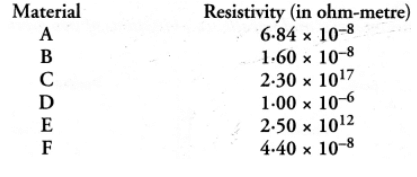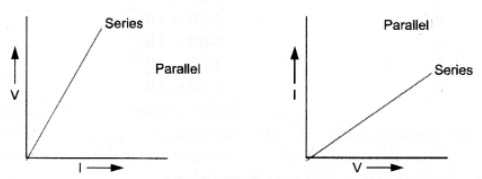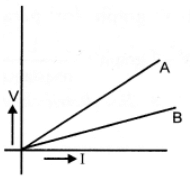Class 10 Science Chapter 11 HOTS Questions - Electricity
Q1: Following table gives the resistivity of three samples in (Ωm) Which of them is a good conductor ? And which of them is an insulator? Explain why ?
Which of them is a good conductor ? And which of them is an insulator? Explain why ?
Ans: A material having low resistivity is a good conductor. Since, resistivity of sample A is the least among all other materials, so sample A is a good conductor. A material having high value of resistivity is an insulator. Therefore, sample C is an insulator.
Q2: The electrical resistivity of few materials is given below in ohm-meter. Which of these materials can be used for making element of a heating device ?
Ans: For making element of a heating device, we use alloy instead of pure metals.The resistivity of material D lies in the range of resistivities of alloys. Therefore, material D can be used for making element of a heating device.
Q3: The following table gives the resistivity of three samples:
Which of them is suitable for heating elements of electrical appliances and why?
Ans: For making the heating elements of electrical appliances, alloy is used instead of a pure metal. This is because alloy does not burn even at higher temperature. The resistivity of sample C is of the order of an alloy, so sample C is suitable for heating elements of electrical appliances.
Q4: Two metallic wires A and B are connected in series. Wire A has length l and radius r, while wire B has length 2l and radius 2r. Find the ratio of the total resistance of series combination and the resistance of wire A, if both the wires are of same material.
Ans:
Q5: Two metallic wires A and B of same material are connected in parallel. Wire A has length l and radius r and wire B has length 2l and radius 2r. Compute the ratio of the total resistance of parallel combination and the resistance of wire A.
Ans:

Total resistance of the parallel combination,
Q6: Two students perform the experiments on series and parallel combinations of two given resistors R1 and R2 and plot the following V-I graphs.
Which of the graphs is (are) correctly labelled in terms of the words ‘series’ and ‘parallel’. Justify your answer.
Ans: In first graph, slope of I-V graph = Resistance.
Since in series combination, resistance is more than the resistance in parallel combination, therefore slope of I-V graph for series combination is more than the slope of resistance.
V - I graph = 1/resistance
Hence, graph is correctly labelled. In second graph, slope of resistance.
Q7: Two electric circuits I and II are shown in figure. (i) Which of the two circuits has more resistance ?
(i) Which of the two circuits has more resistance ?
(ii) Through which circuit, more current passes ?
(iii) In which circuit, the potential difference across each resistor is equal.
Ans: (i) Equivalent resistance of series combination of resistors is more than the equivalent resistance of the parallel combination of resistors. So, the resistance of circuit I is more than the resistance of circuit II.
(ii)
∴ So current in circuit II is more than the current in circuit I.
(iii) Potential difference across each resistor is equal in circuit II.
Q8: An electrician puts a fuse of rating 5 A in that part of domestic electrical circuit in which an electrical heater of rating 1.5 kW, 220 V is operating. What is likely to happen in this case and why ? What change, if any needs to be made ?
Ans: The fuse will melt and the circuit breaks if electric current more than the rating of fuse (i.e., 5 A) flows in the circuit. Electric current flowing in the circuit,
Since, current flowing in the circuit (6.82 A) is more than the rating of fuse (5 A), therefore, the fuse will melt and the electrical heater does not work. To operate the heater, fuse of rating 10 A is to be put in the circuit.
Q10: The electric power consumed by a device may be calculated by using either of the two expressions: P = I2R or P = V2/R . The first expression indicates that the power is directly proportional to R,whereas the second expression indicates inverse proportionality. How can the seemingly different dependence of P on R in these expressions be explained ?
Ans: P = I2R is used when current flowing in every component of the circuit is constant. This is the case of series combination of the devices in the circuit.
P = V2/R is used when potential difference (V) across every component of the circuit is constant. This expression is used in case of parallel combination in the circuit. In series combination, R is greater than the value of R in parallel combination.
Q11: Three V-I graphs are drawn individually for two resistors and their series combination. Out of A, B, C which one represents the graph for series combination of the other two. Give a reason for your answer.
Ans: Slope of V-I graph = resistance of a resistor.
When two resistors are connected in series, Volts the resistance of this combination (R = R1 + R2) is more than the resistance of both the resistors.
 Since, slope of C is greater than the slopes of A and B. Therefore, C represents the graph for series combination of the other two.
Since, slope of C is greater than the slopes of A and B. Therefore, C represents the graph for series combination of the other two.
Q12: V-I graphs for the two wires A and B are shown in the figure. If we connect both the wires one by one to the same battery, which of the two will produce more heat per unit of time? Give justification for your answer.
Ans: Heat produced per unit time = V2/R
Now slope of V-I graph = R (resistance of wire). Since slope of V-I graph for wire A is greater than the slope of V-I graph for wire B, therefore, resistance of wire A is greater than the resistance of wire B. Hence, more heat will be produced per unit time in wire B than in wire A.
Since slope of V-I graph for wire A is greater than the slope of V-I graph for wire B, therefore, resistance of wire A is greater than the resistance of wire B. Hence, more heat will be produced per unit time in wire B than in wire A.
|
85 videos|437 docs|75 tests
|

|
Explore Courses for Class 10 exam
|

|

















